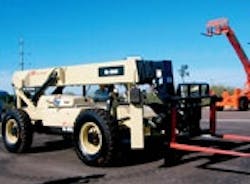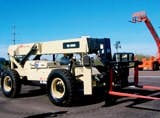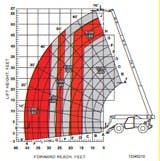Ingersoll Rand VR-1056C
Visibility from the roomy cab is exceptional, thanks in part to the low position of the mid-mounted engine and the minimal obstructions presented by the A Frame-style boom supports. The placement and design of the uprights really improve rearward visibility. The four-section boom is a four-plate design and incorporates an internal crowd cylinder and hose placement.
Although it looks like a typical outrigger set-up, the VR-1056C uses frame-mounted stabilizers. Unlike other units with frame-mounted outriggers that are intended to carry all or part of the load, IR's stabilizers are simply there to provide stability if it is needed. In the down position, the stabilizers are not loaded. Since they are not carrying any weight, the machine design allows full chart capacities in conjunction with frame-sway when the stabilizers are in the lowered position. In this configuration, movement is dampened by about 50 percent and limited to 4° of sway. Shifting the stabilizers is accomplished by transferring oil from one stabilizer cylinder to the other simultaneously with the sway of the machine. Doing this keeps the stabilizer pads just barely, if at all, in contact with the ground.
The VR-1056C's boom is fitted with dual lift cylinders, which provide stable load handling and are cushioned for softer stops. At the tail of the boom, dual master cylinders keep the carriage properly sequenced. The carriage can rotate a full 113°, which is important when working with a material bucket or any other device used to load a dumpster or dump truck.
The 40-gallon hydraulic oil and 35-gallon fuel tanks and their respective fill points are side-mounted opposite the cab and sit right next to each other. Machine owners need to make sure the lockable caps are kept in place to avoid cross contamination.
Ingersoll Rand also provides an option to combine these functions into a single controller. The thoughtful location of the load chart on the dash, and the flip-up keyhole protector, are simple but effective features. All gauges are analog to provide clear engine status.
Powering the VR-1056C is a 110-hp Cummins QSB 4.5-30-T turbocharged diesel engine, which is mid-mounted in-frame and resides under a sliding fiberglass hood. Everything is top mounted with only the starter requiring extra effort for access.
While all the Showcase participants featured some type of rear-axle stabilization system, the VR-1056C is a totally isolated system. If the main hydraulic system should fail for any reason, this machine will not be affected. The unit also uses a fully modulated Dana T12000 three-speed forward and reverse, power-shift transmission, and internal wet disc brakes are incorporated on the front and rear axles.
 The VR-1056C is the largest product in Ingersoll Rand's VR telehandler line-up, and it is built at the company's plant in Shippensburg, Pa. Although mainstream in capabilities, the VR-1056C features a different route in its design and application of some key operating systems.
The VR-1056C is the largest product in Ingersoll Rand's VR telehandler line-up, and it is built at the company's plant in Shippensburg, Pa. Although mainstream in capabilities, the VR-1056C features a different route in its design and application of some key operating systems.

